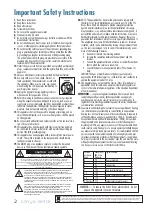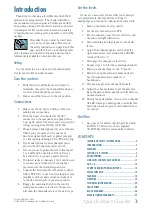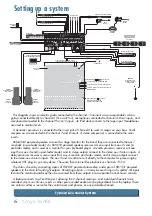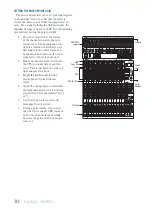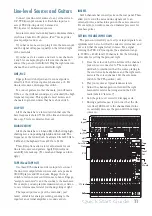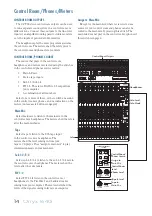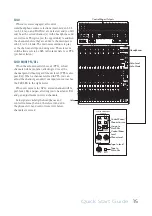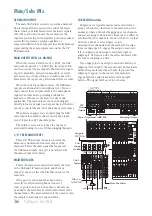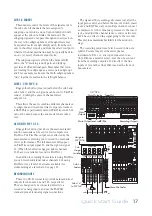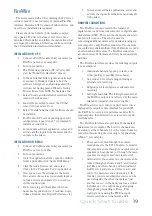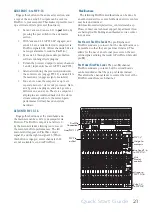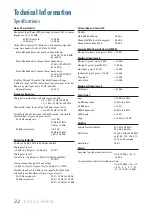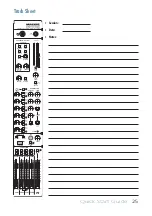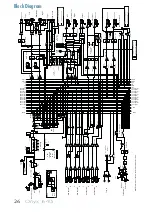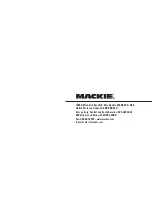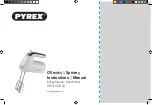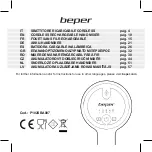
Quick Start Guide
13
Modifi cation: Pre-EQ Aux Sends
The pre-fader aux sends are post-EQ, so they are
affected by the channel EQ controls. The circuit boards
can be modifi ed so the pre-fader aux sends are pre-EQ
instead of post-EQ. For example, your stage monitors
will not be affected by any channel EQ adjustments.
This modifi cation can be done by an authorized service
center. Contact our technical support chaps for details.
AUX RETURN 1-4
These 1/4" TRS stereo input connectors allow you to
add the stereo processed output from external effects
processors or other devices to the main mix. Adjust the
level of the incoming signals with the aux return master
controls.
Alternatively, you can use these inputs to add any
stereo line-level signals to your main mix, so it could be
another line-level source, not just an effects processor.
If you are connecting a mono source, use the left
(mono) aux return input, and the mono signals will
appear on both sides of the main mix.
EFX TO MON Level Controls
These controls route the signal from aux returns 1
and 2 to the aux 5 and 6 sends. This allows you to use an
external effects device, like a reverb or delay,
exclusively for the monitors. When these controls are
turned up, the stereo effects return signal is summed
to mono and combined with the signals coming from all
the channel aux 5 and aux 6 send controls.
If you want to add reverb or delay to the stage monitor
mixes, these are the knobs for you. Operating
independently of their respectively numbered aux
returns level controls, these knobs are exactly the same
as the aux 5 and aux 6 knobs found in the channel strip.
These two knobs feed their respective stereo aux
return signals to a mono summing amp and then: 'to
aux 5' feeds 'aux return 1' to 'aux send 5' master, and 'to
aux 6' feeds 'aux return 2' to 'aux send 6' master. They
are off when fully turned down, and provide up to 10 dB
gain turned fully up.
RETURN 3 to MAIN/SUBS
With this button up, aux return 3 behaves like the
other aux returns - it delivers a stereo signal, regulated
by its level knob, to the main mix. When you push this
button in, the aux return 3 signals are removed from
the main mix buses and sent to the subs 1-2/3-4 switch,
which diverts the signal once more.
If the aux returns 3 send to main/subs button is up,
the subs 1-2/3-4 button does absolutely nothing. Let's
now assume it is pushed in. Aux return 3's stereo signal
will not be sent to the main mix, but to the subgroup
faders 1 and 2 (subs 1-2/3-4 button up) or to subgroup
faders 3 and 4 (subs 1-2/3-4 button down).
Let's say you've made a stereo drum submix on
subgroup faders 1 and 2, so you can ride those two
faders instead of the seven channels that the drums
came from. Subgroup fader 1 has its assign to main mix
left button engaged and subgroup fader 2 has its assign
to main mix right button engaged, blending the drum
submix back into the main mix. The drum channels are
also sending signals to your reverb via the aux sends and
the reverb outputs are patched into the aux return 3.
Even though you could send aux return 3 directly to
the main mix (aux return 3 send to main/subs button
up), you don't want to. Instead, engage the aux return
3 send to main/subs switch and make sure the subs
1-2/3-4 switch is up. Now the reverb return is blended
into the drum submix, and as you ride the two subgroup
faders, the reverb level will follow.
Why do we want that? Because if you had just sent
the reverb directly to the main mix (aux return 3 send
to main/subs button up) and you did a drum fade-out
using the subgroup faders 1 and 2, the "dry" signals
would fade out, but the "wet" signals would continue on,
defeating the purpose of the ever-important drum
fade-out. All you would hear is the drum reverb (the
"wet"), and none of the original drum signals (the
"dry"). That is because the reverb is being fed by the
channel's aux send, and they have no idea that you've
pulled down the subgroup faders. That is why we
included these switches.
RETURN 4 to CR/PHONES
When this button is up, aux return 4 is routed to the
main mix bus, just as aux returns 1-3 are. When this
button is down, the aux return 4 stereo signal is routed
to the CR/phones matrix instead. It does not matter if
any of the source buttons are assigned, but it will be
interrupted, as usual, if a solo button is engaged.
Let us pretend that you are doing a live mix to a
computer, a house PA, or both, and you want to play
along to a click track. You could run the click track
directly into the main mix, but you do not want the
computer or audience to hear it. Instead, it may be
routed directly to the control room and phones outputs.
Similarly, it may be used for voice-over tracks,
narration, anything you want heard by the engineer and
players but not by the audience and mixdown
deck/computer.


